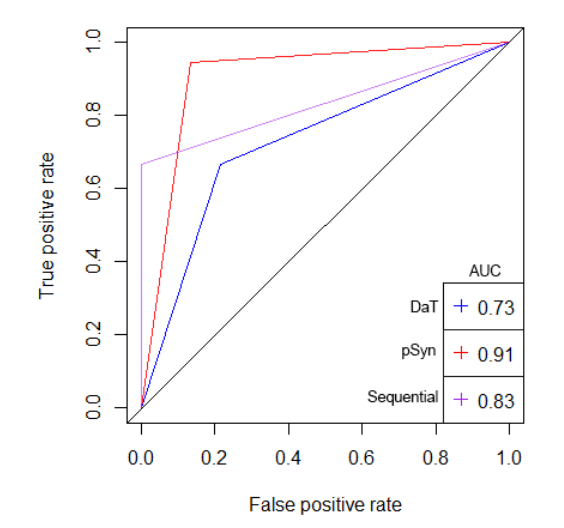Category: Parkinsonism, Others
Objective: To examine the utility of commercially available skin phosphorylated alpha-synuclein deposition test (pSyn) in patients with clinically ambiguous parkinsonism and its concordance with dopamine transporter (DaT) SPECT changes.
Background: Diagnosis of parkinsonism is challenging in early disease stages [1]. DaT SPECT [2] and pSyn skin biopsy [3] are two clinically available biomarker tests that can potentially lower diagnostic uncertainty. Most efforts to describe the performance of these tests have not studied patients with ambiguous presentations in real world practice outside clinical research. There is currently no data regarding concordance or their utility together in guiding diagnosis.
Method: This is a retrospective study of patients who had a pSyn biopsy performed to clarify the diagnosis of tremor or parkinsonism. We calculated diagnostic performance statistics for each test based on clinician diagnosis of established or probable PD or PSP (pre/post-test). We then created a model where DaT SPECT is done first and then pSyn biopsy only if the result of the DaT SPECT is negative, with either test positive considered diagnostic.
Results: We reviewed data of fifty-two patients with p-Syn biopsy results. Twenty eighth had DaT SPECT. DaT and pSyn studies coincide in 69.23% of cases, with Cohen’s kappa 0.38 corresponding to minimal concordance [4]. Table 1 shows sensitivity, specificity, and likelihood ratios for both diagnostic tests. Sequential testing had the highest negative predictive value and true positive rate ([Figure 1]). Two of our cases that tested positive for pSyn had “probable PSP” by current diagnostic guidelines [5].
Conclusion: Concordance among both tests is minimal in this cohort, pointing at the need for a systematic approach to testing and decision making. We found that performing DaT SPECT first and then pSyn biopsy provides the highest diagnostic utility. The presence of positive pSyn in cases with clinically evident, probable PSP further highlights the need for clinical equipoise in interpreting biopsy results.
Figure 1
Table 1
References: [1] Bajaj N, Hauser RA, Seibyl J, et al. Association between Hoehn and Yahr, Mini-Mental State Examination, age, and clinical syndrome predominance and diagnostic effectiveness of ioflupane I 123 injection (DaTSCAN™) in subjects with clinically uncertain parkinsonian syndromes. Alzheimers Res Ther. 2014 Oct 8;6(5-8):67.
[2] Kägi G, Bhatia KP, Tolosa E. The role of DAT-SPECT in movement disorders. J Neurol Neurosurg Psychiatry. 2010 Jan;81(1):5-12.
[3] Gibbons CH, Freeman R, Bellaire B, Adler CH, Moore D, Levine T. Synuclein-One study: skin biopsy detection of phosphorylated α-synuclein for diagnosis of synucleinopathies. Biomark Med. 2022 May;16(7):499-509.
[4] McHugh ML. Interrater reliability: the kappa statistic. Biochem Med (Zagreb). 2012;22(3):276-82.
[5] Höglinger GU, Respondek G, Stamelou M, et al. Clinical diagnosis of progressive supranuclear palsy: The movement disorder society criteria. Mov Disord. 2017 Jun;32(6):853-864.
To cite this abstract in AMA style:
A. Martinez Nunez, N. Walker-Pizarro, A. Wagle Shukla, A. Ramirez-Zamora, N. Mcfarland. Real-world use of biomarkers for Parkinsonism: Should I do this (pSyn) or DaT? [abstract]. Mov Disord. 2024; 39 (suppl 1). https://www.mdsabstracts.org/abstract/real-world-use-of-biomarkers-for-parkinsonism-should-i-do-this-psyn-or-dat/. Accessed December 25, 2025.« Back to 2024 International Congress
MDS Abstracts - https://www.mdsabstracts.org/abstract/real-world-use-of-biomarkers-for-parkinsonism-should-i-do-this-psyn-or-dat/


